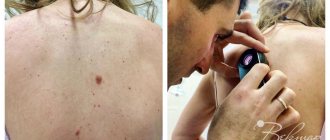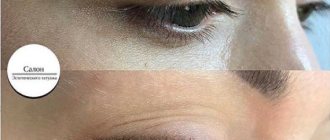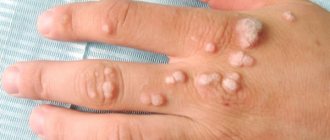Moles are benign pigmented formations on the skin, which in medicine are usually called nevi. These spots can be present on the body at birth and appear until puberty, and then remain on the body forever. Moles sometimes cause inconvenience and injury, which can ultimately cause malignancy. Or they can simply be located in a visible place and spoil a person’s appearance. In this case, the mole must be removed, one of the methods is the radio wave method.
The essence of the radio wave method
Compared to surgical and other methods of removing moles, the radio wave method is considered very gentle, and at the same time very effective. The high-frequency waves used generate thermal energy, and without contact with the skin, they carefully cut tissue, while evaporating pigmented cells, leaving only a barely noticeable trace. During radio wave removal, no physical pressure is applied to the skin.
Important: Radio wave surgery is the most effective method of removing moles, as it leaves only a small depression. When the operation is over, the wound is treated with an antiseptic, and after a couple of weeks it smoothes out.
Features of the action of radio waves
High-frequency radio waves, acting as a scalpel, act on the mole to be removed: a tungsten electrode, heated by current, instantly “cuts off” the pigment formation. The tissues around it seem to be cauterized, the blood vessels are “sealed”. This is a bloodless operation: bleeding is excluded, as is the risk of infection. The technique is extremely gentle and differs from other methods in the absence of physical pressure on the surface of the skin.
Only the areas that need to be removed are processed. The removed tissues are necessarily sent for histology to exclude the possibility of cancer.
Radio waves do not have a negative impact on health. They are focused on one problem area. The main indication for the radio wave procedure is non-cancerous skin formations. This method can also be used to remove moles diagnosed as a precancerous condition.
Benefits of radio wave mole removal
- radio waves do not damage healthy tissues, leaving them completely intact;
- the duration of mole removal using a radio wave knife is only twenty minutes;
- there is no bleeding during the procedure;
- even without anesthesia, the intervention is absolutely painless;
- there are no complications after the operation, and the postoperative period is very short;
- There are no scars left after removal of moles by radio waves;
- the likelihood of inflammation, redness or swelling after the procedure is extremely low;
- During the operation, the tissues are sterilized, thereby reducing the likelihood of complications;
- After surgery, the wound does not need special care;
- radio waves do not destroy tissue during removal, so histological analysis can be carried out;
- Using a radio wave knife, you can remove a mole anywhere.
What it is
Surgitron is a modern method for eliminating complications in the postoperative period. It is carried out using the apparatus of the same name. The therapy is effective and accessible to most patients.
The essence of this procedure is to incise soft tissue in a safe and gentle way. In this case, do not use a scalpel or other sharp cutting objects.
It is popular due to the following actions:
- painless surgery;
- short time;
- no scars or scars after use.
Using the device does not provoke the development of inflammation or suppuration of wounds.
Contraindications to radio wave surgery
Removing moles with a radio wave knife has a number of contraindications that need to be taken into account:
- if skin tumors have already degenerated into cancer, then more serious therapy is required;
- It is unacceptable to use a radioknife if there are heart rate sensors in the patient’s body;
- in case of chronic inflammatory skin diseases in the area of mole removal, it cannot be removed with a radio knife;
- The radio knife is prohibited for use during breastfeeding or pregnancy, so as not to accidentally affect the baby;
- In case of a viral infection of the skin, for example, with herpes, using a radio knife will have to wait a little.
Recovery and care
Cauterization with Surgitron is not accompanied by a long period of rehabilitation. It will take a short time to recover. In rare cases, complications may develop.
The duration is determined by the doctor individually, taking into account the complexity of the procedure and the reaction. If the patient observes the occurrence of suspicious symptoms, you should contact a specialist.
Standard rules of care for the prevention of infectious lesions.
- After treatment of cervical erosion, it is necessary to avoid physical activity and sports for a month. It is not recommended to walk a lot or lift heavy objects. Sexual activity is prohibited.
- Mole removal is often performed using the Surgitron device. During the rehabilitation period, it is forbidden to take a bath, go to the pool, sauna, or solarium. Swimming in open waters is not permitted. Only showers are allowed. The water should be warm, but not hot.
- When menstruation occurs, it is prohibited to use tampons.
- Massage and cosmetic procedures are not recommended.
- Do not apply gels or scrubs to the affected area of the skin for 1 month. In the first days, the wound is washed with warm water and antiseptics. After a week, you can use baby soap.
- The following creams will help speed up the regeneration of damaged skin: Bepanten, Panthenol.
It is forbidden to use any means, especially medications, on your own. They must be prescribed by a doctor. Otherwise, there is a risk of complications and unwanted reactions.
The occurrence of discomfort and other suspicious signs should be a reason to visit a specialist.
The process of radio wave removal of moles
The radio wave method is effective due to the fact that radio waves act specifically on the area of the mole, eliminating unnecessary and unnecessary damage to healthy tissue. This is done due to steam bubbles, which are formed under the influence of high-frequency radio waves and gently move the tissue apart. As a result, only the cells in the wave zone are destroyed. Thanks to this, there are no scars or scars left on the skin, and the procedure remains painless. To completely eliminate pain, local anesthesia is performed before the procedure. The radio knife, which is used to carry out the procedure for radio wave removal of a mole, performs three functions simultaneously:
- cuts fabrics;
- disinfects the affected area, completely eliminating the possibility of infection;
- stops bleeding in the affected area, eliminating the need for the doctor to apply stitches.
Radio wave surgery is the most effective method for removing moles, as it leaves only a small indentation. When the operation is over, the wound is treated with an antiseptic, and after a couple of weeks it smoothes out.
Types of skin formations
All benign skin formations are conventionally divided by color, size, shape and surface texture. The generally accepted classification includes only two types of moles - congenital and acquired. Congenital nevi are divided by size into: small (1.5 centimeters in diameter), medium (no more than 10 centimeters), large (more than 10 centimeters), giant.
Giant formations cover the entire anatomical region (for example, the face). Small moles are safe and rarely develop into malignant tumors. Owners of giant moles should be on alert, since in 50% of cases they degenerate into melanoma. To protect yourself, perform regular self-examinations and consult a dermatologist. Acquired moles begin to form in childhood. It is at this time that the restructuring and development of the entire organism occurs.
Melanocyte cells rise from the deep layers of the skin to its surface - the epidermis, where they accumulate and provoke the growth of moles. The location, size and number of nevi are determined by genetic factors, lifestyle, and external environment. Acquired moles are classified by location:
- epidermal (accumulation of pigment cells in the upper layers of the skin);
- intradermal (accumulation of melanocytes in the deep layers of the skin or dermis);
- borderline (accumulation of melanocytes at the border of the upper and lower layers of skin).
Rehabilitation after the procedure
Since during radio wave removal of moles the electrode does not come into contact with the skin, complications after the procedure are almost completely eliminated, and rehabilitation proceeds smoothly. There are only a number of recommendations that should be followed in order to completely avoid the formation of a scar:
- in the first few weeks after the procedure, do not stay in the bright sun for a long time, and also use sunscreen;
- Do not visit the bathhouse, swimming pool or sauna for several days, and do not wet the site of the removed mole;
- Treat the skin in the affected area with an antiseptic three times a day for several days.
Remember that mole removal is a completely safe operation, and it is neither difficult nor painful, so you should not be afraid of it. If a mole begins to increase in size and bother you, then you should quickly visit a dermatologist to remove a suspicious skin growth. If a mole begins to bother you, then you should quickly visit a dermatologist to remove a suspicious skin growth.
Important: In case of chronic inflammatory skin diseases in the mole removal area, it cannot be removed with a radio knife.
Causes of neoplasms
Children's skin is especially delicate and has an increased degree of sensitivity to any external influences. Often the cause of the development of skin pathologies is exposure to direct sunlight, from which not only infants, but also older children should be protected. However, this is just one reason. Some skin pathologies develop in children regardless of external causes: neoplasms can be congenital (the reason for this may be, for example, heredity).
Benign formations on the skin of children extremely rarely turn into malignant ones (unlike adults). However, it is worth noting that it is much more difficult to notice this pathology on a child’s body than in an adult. The peak age for the development of skin tumors in children is considered to be up to 8 years of age. Some skin pathologies develop from 8 to 15 years, but in this case they tend to grow slowly and are mostly unnoticeable.
Experts do not recommend that parents worry about every new mole on their child’s body. The fact is that a disease such as skin cancer is quite rarely diagnosed in children. However, there are a number of diseases (for example, congenital pigmented nevi) that require constant medical monitoring. Large pigmented moles tend to increase in size, often change color, and can be injured by clothing - all this can lead a benign neoplasm to transition to a malignant stage. That is why today radio wave surgery is becoming increasingly in demand, making it possible to get rid of unwanted tumors and prevent the risk of developing serious diseases in children. In addition, these operations are also popular from an aesthetic point of view, since large tumors can significantly spoil the baby’s appearance (especially when located on open areas of the body).
Efficiency of the procedure
In general, people note that removing moles with radio waves is really quick, simple and without problems, and there are no scars left after this. Before the procedure, many advise first visiting an oncologist to make sure that the mole is not dangerous, and after removing it, take the mole for analysis to completely exclude the possibility of a malignant formation. The only drawback of the radio wave method, which patients call, is its rather high cost compared to the same surgical removal.










